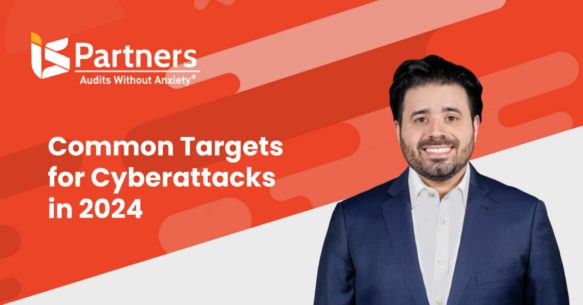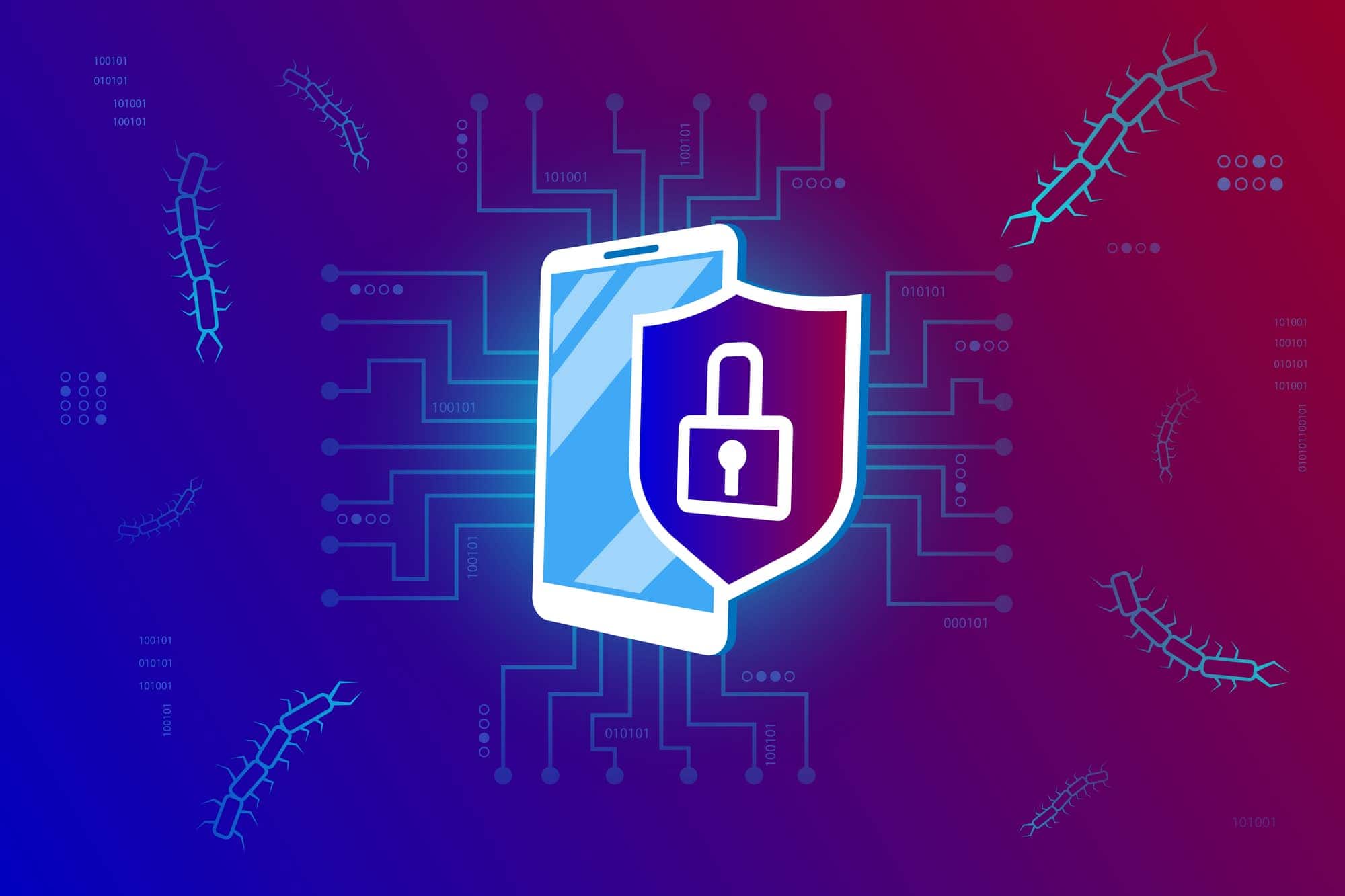Key Takeaways
1. Cyberattacks target diverse industries, including small and medium businesses, healthcare, government, and educational institutions, due to valuable data and weak defenses.
2. The key to creating a comprehensive cybersecurity system is to assess risks and vulnerabilities.
3. I.S. Partners is an accredited CPA firm that conducts thorough risk assessments and helps organizations implement security frameworks.
What Industries Are Prime Targets for Cyberattacks?
Cyberattacks are a major threat impacting common types of industries such as:
- Small and Medium-Sized Businesses (SMBs),
- Healthcare Organizations,
- Government Agencies, and
- Educational Institutions.
These sectors are often targeted due to their valuable data and sometimes weaker cybersecurity defenses. Common threats include ransomware, which can cripple operations; phishing emails, which trick individuals into revealing sensitive information through a malicious code; and data breaches, which lead to unauthorized access to personal and financial data.
Another common type of cyber attack for these industries is distributed denial of service (DDoS) attacks. In DDoS attacks, a perpetrator seeks to make a machine or network resource unavailable to its intended users by temporarily or indefinitely disrupting the services of a host connected to the Internet.
Understanding these threats and their impacts is crucial for developing effective cybersecurity strategies to protect against these pervasive dangers.
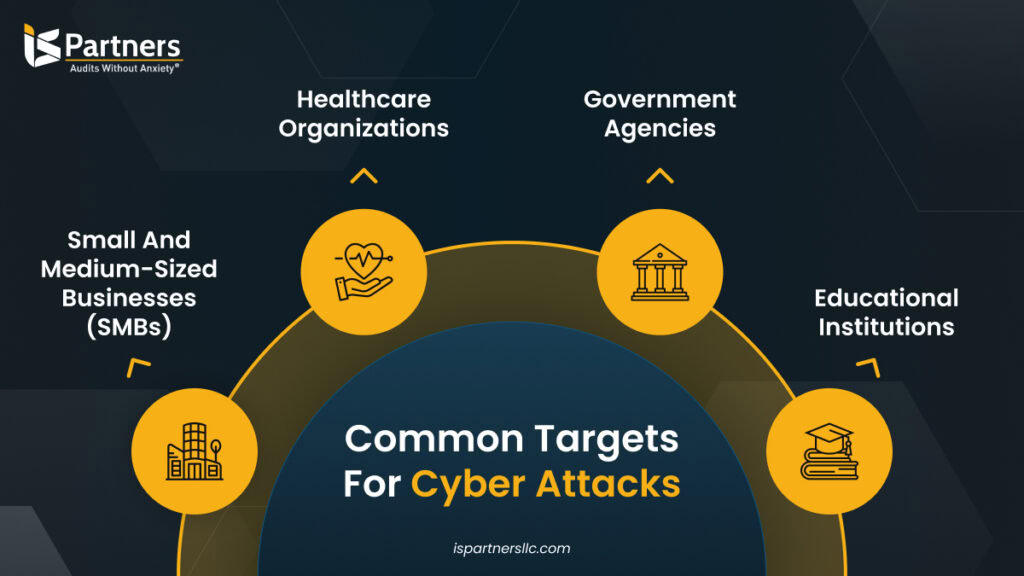
Small and Medium-Sized Businesses (SMBs)
SMBs have been identified as some of the most common targets for cybercriminals. This is mainly because of their limited resources and access to cybersecurity expertise, which makes it challenging to implement the proper cybersecurity controls and best practices.
Recent statistics show that as much as 43% of cyberattacks target small businesses, with 60% of SMBs going out of business within six months of a successful attack.
A subset of this problem includes small family offices. Cybercrime aimed at businesses operating in their homes and managing their assets has increased significantly. Recent news showed that approximately 79% of North American families operating in family offices say that the likelihood of a cyberattack has increased.
SMB challenges that significantly affect their cybersecurity include the following:
- Lack of budget. It is difficult for SMBs to invest in advanced cybersecurity solutions and hire dedicated information systems staff as finances are usually limited to operational expenses keeping the lights on.
- Lack of threat intelligence. Many SMB owners and employees are not aware of the real world dangers of modern IT systems, or cybersecurity best practices. This lack of awareness makes them more susceptible to social engineering tactics like spear phishing, where clicking a malicious link and entering personal information can spell disaster if it gives an attacker access to sensitive resources like financial or confidential data.
- Lack of security measures. Because of SMBs’ limitations in budget and awareness, they often rely on older technologies or outdated best practices that can potentially leave them more vulnerable to modern cyberattacks, which are evolving all the time.
Ransomware, phishing, and malware are all serious threats to these businesses, which is why proper protection and employee education are so important. As cybersecurity threats continue to become more advanced, older safeguards and security measures become ineffective and leave SMBs more vulnerable.
Healthcare Organizations
Healthcare organizations are frequent targets of cyberattacks because they store large amounts of sensitive patient data, making them attractive for identity theft and financial fraud. Additionally, the critical nature of healthcare services creates urgency, making organizations more likely to pay ransoms to regain access to their systems.
The healthcare sector has been targeted for cyberattacks quite heavily in the past decade. In 2023-2024 alone, over 725 healthcare providers reported data breaches. Attackers know the value of sensitive patient data, filled with valuable PII (Personally Identifiable Information) and PHI (protected health information).
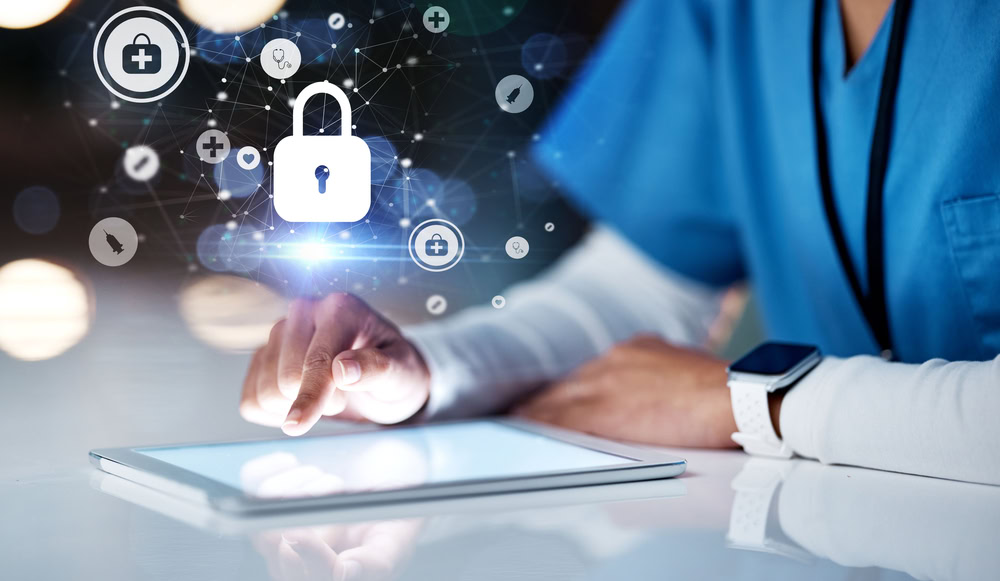
In some cases, financial information, such as those from credit cards, is obtained in these attacks, which is then sold on black markets on the dark web.
Damage caused by healthcare cyber attacks includes the following:
- Danger to patient safety. When malicious software like ransomware disrupts hospital operations, administrative tasks, and general IT systems, it increases the chances of a direct impact on patient care. If the hospital is disrupted to the point where patient records are no longer accessible, or medication cannot be dispensed, people’s lives could be put in danger. In extreme cases, manual processes must be used with physical registers and record keeping, which is not efficient or secure.
- Imposed regulatory fines. Healthcare organizations must comply with strict regulations like HIPAA. Data breaches can result in severe fines and even legal action if they are severe enough.
- Damage to reputation. Patients trust healthcare providers with extremely confidential information. A breach can destroy that trust and damage the organization’s reputation, negatively affecting business operations.
Protecting patient data and retaining regulatory compliance is critical. Healthcare organizations must prioritize cybersecurity and roll out all necessary security measures to detect and respond to cyber threats.
Government Agencies
Government agencies are another common target for cyberattacks. They hold classified information and play a vital role in national security, making it a desirable target for cybercriminals.
Different groups of threat actors target government departments and agencies that might not have a monetary goal in mind. These groups include nation-state actors or hacktivist groups that may target government agencies for many different reasons, like espionage, sabotage, or even political reasons.
A cyberattack in 2024 exposed confidential documents and disrupted public services in Fulton County, Georgia. This massive ransomware attack was carried out by the LockBit ransomware group, which is known for attacking various entities around the globe.
LockBit has claimed more than 2,000 victims worldwide and extorted approximately $120 million in ransom payment, with government agencies like Fulton County being among those mainly affected. The main cause of the breach was the exploitation of a known vulnerability in the PHP scripting language, which allowed federal investigators to hack into LockBit’s systems.
The effects of an attack on a government agency may lead to the following outcomes:
- National security risks. Leaked classified information can threaten military operations, strain diplomatic relations, or even cause issues with critical infrastructure like power plants, waterworks, and other essential services.
- Economic impact. Cyberattacks have the potential to disrupt government services, which can lead to downtime and erode public trust over time. Citizens need to have faith in the government’s ability to protect sensitive data, and data breaches damage that trust.
- Geopolitical tensions. Nation-state actors have the ability to use cyberattacks to wage political warfare and escalate tensions between countries, which can potentially lead to real-world conflicts.
To minimize these risks where possible, government agencies must adopt a hands-on cybersecurity approach by investing in advanced threat detection and response capabilities. User training and security awareness play a massive role in minimizing avoidable incidents such as phishing and malware campaigns targeting government agencies’ departments and branches.

Educational Institutions
Educational institutions are frequent targets of cyberattacks because they store valuable personal and financial data and often have limited cybersecurity resources in their computer system. This aspect makes them easier to exploit.
The high number of users, including students and staff, using personal devices and login credentials increases the potential entry points for attackers. Disrupting educational activities can create urgency, making institutions more likely to pay ransoms.
In a recent incident, the University of Michigan fell victim to a cyberattack that compromised the personal data of up to 230,000 students, faculty, and staff members. The malware attack, from August 23 to August 27, 2023, led to unauthorized access to sensitive information, including Social Security numbers, driver’s license numbers, financial account details, and health information.
Educational data being targeted include the following:
- Student records. Personal information, financial aid data, and academic records are valuable targets for identity thieves and fraudsters who sell and repurpose this data for illegal activities.
- Research and intellectual property. Universities are at the cutting edge of innovation, and the theft of proprietary research data can have financial and competitive ramifications when it is commercialized.
- Alumni and donor information. Educational institutions often maintain databases of alumni and donors, which can be targeted for phishing and social engineering attacks.
Educational institutions are common targets of cybercrime, such as brute force attacks in which threat actors manually guess login credentials. This occurs because of low security in computer networks. Comprehensive cybersecurity strategies are needed to protect this sensitive data.
Latest Trends in Cybersecurity Threats and Solutions
Cyber threats are always changing, so any organization that handles sensitive data needs to keep up with the latest trends. The increased dependence on cyber solutions has exploited several newer vulnerabilities in different industries.
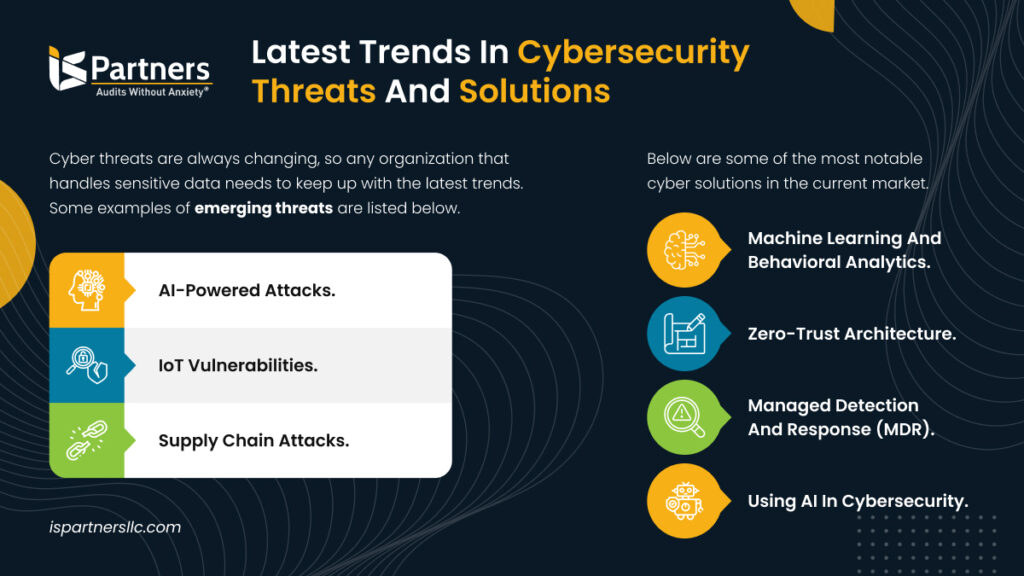
Some examples of emerging threats are listed below.
- AI-powered attacks. Cybercriminals are starting to use artificial intelligence and machine learning to create more advanced and fine-tuned attacks. These include enhanced phishing attacks, automated hacking attempts, and deep fakes.
- IoT vulnerabilities. Internet of Things (IoT) devices are being used more often in homes and businesses, which inadvertently creates security weak points for attackers to take advantage of if these systems are not locked down adequately.
- Supply chain attacks. Cybercriminals are increasingly targeting third-party vendors and suppliers. This is done to gain access to customer and client information, as seen in the SolarWinds attack.
While these threats are undeniably critical, their root causes can be used against them. With proper strategies and comprehensive security implementation, advancements like AI and machine learning can significantly protect your systems.
Below are some of the most notable cyber solutions in the current market.
- Machine learning and behavioral analytics. These technologies can help detect suspicious activities and identify potential threats in real time, which enables faster response times and mitigation.
- Zero-trust architecture. Zero-trust assumes that no user or device can be trusted by default. Zero-trust models require strict identity verification and access controls, which reduces the risk of unauthorized access.
- Managed detection and response (MDR). Outsourcing threat detection and response to a specialized provider can help organizations with limited in-house resources maintain stronger security within their systems.
- Using AI in Cybersecurity. Large datasets are being used to train AI systems on how to detect and counter suspicious network traffic. This is used in devices like firewalls and software applications and have the potential to identify threats before they can spread too far across a network.
Cyber threats continue to change and become more sophisticated. Organizations are starting to use artificial intelligence (AI) to strengthen their defenses. AI-powered cybersecurity solutions can help detect and respond to threats in real time, reducing the risk of successful attacks.
Start your initiative towards cybersecurity with the help of I.S. Partners’ experts. We are an auditing firm with over 20 years of experience in the compliance industry. Our US-based CPAs can help you navigate through the necessary frameworks that can help you secure your system effectively.
Strengthening Your Organization’s Cybersecurity
Organizations are expected to avoid cyber threats by strategizing against them and understanding their root causes. This is a critical step for any company that handles sensitive information.
Here are some basic steps that you can follow to improve your day-to-day cybersecurity.
- Assess your risks. Risk assessments are needed to identify vulnerabilities and prioritize assets that could leave your organization vulnerable during a cybersecurity incident. Develop a customized security strategy that suits your environment and needs.
- Educate your employees. Phishing attempts and suspicious activities are easy to avoid with the right training. Carry out regular cybersecurity awareness training to help employees recognize and report potential threats when they see them in their daily work.
- Implement robust access controls. Enforce strong password policies and enable multi-factor authentication.
- Keep software and systems up to date. Basic housekeeping can present serious issues later. Maintain a regular patch and update schedule for all live software, operating systems, and devices on your networks. This basic step can help you address known vulnerabilities and reduce your organization’s attack surface.
- Develop an incident response plan. Creating a comprehensive incident response plan is essential. Your plan should outline the various roles, responsibilities, and procedures for responding to incidents. These include detecting, containing, and recovering from a cybersecurity incident when it happens.
- Conduct regular testing and audit. Penetration testing and vulnerability scans are vital steps that you need to take to maintain security on your network and applications. Security audits are also important as they will help you to identify weaknesses and ensure compliance with industry standards and regulations.
- Partner with a trusted cybersecurity provider. Consider working with an experienced cybersecurity partner, such as I.S. Partners, to benefit from their expertise and experience. They have the resources, knowledge, and support to implement effective cybersecurity measures that protect your systems and keep you compliant.
In addition to these cybersecurity strategies, service organizations have also started to use cybersecurity insurance as a contingency plan. Cybersecurity insurance policies generally provide financial protection against the fallout of various cyber incidents, including data breaches and ransomware attacks. These policies often cover the costs of responding to breaches, restoring compromised data, and ensuring compliance with legal and regulatory requirements.
The Role of I.S. Partners in Strengthening Cybersecurity
Emerging threats in cybersecurity consistently evolve and progress into more complicated challenges. Every organization must adequately prepare for potential attacks. This critical step must start with a comprehensive assessment of existing security systems.
With a wealth of expertise and a commitment to excellence, I.S. Partners provides tailored guidance and comprehensive solutions designed to elevate your cybersecurity posture. Our team conducts thorough cybersecurity risk assessments, meticulously identifying vulnerabilities and prioritizing risks to craft customized security strategies that align with your unique business objectives.
Working closely with you, we design and implement secure and scalable security systems, ensuring robust protection while supporting your organizational growth and innovation.
By partnering with a trusted cybersecurity provider like I.S. Partners, organizations benefit from years of experience, implementing cutting-edge solutions and dedicated support to develop their defenses against modern businesses’ ever-changing cyber threats.
Contact us today or schedule a free consultation meeting with our experts.
